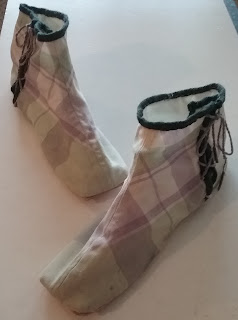Now that I have proper lasts to play with, I decided to take apart and remake the plaid gaiters that were my first pair of non-slipper shoes. They worked, to a certain extent (especially after I had glued on an outersole so the stitches weren't exposed), but had always fit a poorly due to my inexperienced attempt at adjusting the width. I figured that I was unlikely to wear them again in their current state, so I might as well use the material to practice on and, in the best case scenario, get a little more wear out of them as well.
 |
| Before: Dirt, worn out binding, and very clunky soles. |
After disassembling the whole shoes, including removing the binding and cutting away the damaged parts of the lining, I washed the wool uppers (which mostly took off the surface dust, but had little effect on the serious stains around the lower edge), cut new linings by tracing the old ones, and pieced them in along either side of the eyelets. I considered adding foxing, mostly to cover the aforementioned stains, but decided to save the material. As it turned out, the worst of the stains found their way into the lower seam allowance.
 |
| Fitting in the new linings. |
Then, I re-bound the uppers with wool tape; I did the same with the tongues, because I had bound them before and wasn't sure if I had enough seam allowances to sew them wrong sides together and turn. I also added a heal stiffener along the center back of the upper (just a piece of crinoline, so that it would turn easily). Then it was a matter of tracing the last and cutting the soles (which went more smoothly this time, hopefully I'm improving). I decided to try sewing the soles properly this time, based on the turn-shoe method given in Every Lady Her Own Shoemaker. I also consulted Nicole Rudolph's Gonzo cosplay shoe-making video (even though I'm not making a welted shoe) to get my head around the book's description of skiving and pricking the sole.
 |
| Results: a qualified success. |
The sewing part went faster and easier than previous attempts (I credit the curved awl and tapered edges of the sole), and I managed to attach both soles in a single afternoon's work. Turn them right-side out also went easier than I feared. The result shoes are very light (and feel quite flimsy compared to the double-layer soles on my other recent pair). They fit just fine, and I'm not swimming in them like before. I also like that they have a more defined shape off the foot, and especially the distinctive square toe of this time period.
No comments:
Post a Comment
Thanks for commenting!